How to Paint a Flower
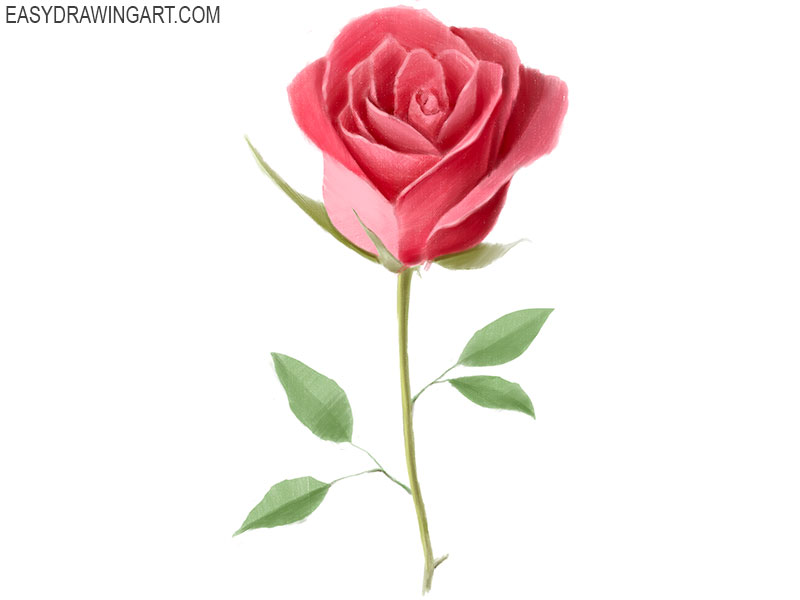
Want to learn how to paint a flower that look fresh off the garden? Our tutorial teaches you techniques for realism in your floral artworks.
This tutorial will show you the process of painting a flower using a rose as an example. But before we get into the steps, let’s look at the really important things you should know before you start.
Colors are the essence of painting a flower, and choosing the right palette is crucial. For a rose, you’ll need a range of pinks – from delicate pastels to deep fuchsias – complemented by greens for the stem and leaves, and a spectrum of tones for shadows and highlights. Consider the mood you want to convey with your rose: Warm tones can evoke passion, while cooler tones can suggest serenity.
Light and shadow give your flower painting form and dimension. Observe how light falls on a real flower. Notice where the shadows lie between petals, under the flower, and where the leaves tuck behind the stem. These observations will inform where to paint the darkest tones on the flower. Conversely, note where the light hits the petals directly – these spots will receive the lightest hues and highlights.
Highlights are crucial for creating a sense of depth and luminosity. Using lighter shades of your base colors, you’ll add touches where the light naturally strikes the most protruding parts of the petals and leaves. These will often be the final touches that make your flower pop.
How to Paint a Flower
Step 1 – Draw the basic outlines of the flower
Select a fine-tipped brush or a pencil to sketch the flower’s fundamental form. Delicately trace the contours of the bud, carefully illustrating its oval shape and the gentle folds of the petals. Extend the lines to form the long, slender stem and add oval shapes for leaves. This initial sketch should capture the flower’s posture, the tilt of the bud, and the arrangement of leaves, providing a structural blueprint for your flower painting without any interior details, ensuring accuracy in proportion and positioning for a balanced composition.

Step 2 – Paint the bud of the flower
Choose a soft, pale pink paint to lay down the first layer of color. Cover the flower bud entirely with this base hue, using smooth, even strokes to avoid streaking. This stage is not about nuance but establishing a uniform foundation of color. The shade chosen will set the tone for the entire flower, so it should reflect the flower’s natural hue. This colored silhouette of the bud now stands out against the canvas, setting the stage for subsequent layers and providing a guide for where to build up color and where to restrain it.

Step 3 – Paint the stem and leaves of the flower
With a steady hand, switch to a green palette and fill in the stem and leaves, ensuring that the green does not bleed into the pink of the bud. This green should be a mid-tone, neither too dark nor too light, to allow for the addition of shadows and highlights later. Apply the paint smoothly to cover these elements completely, providing a solid, vibrant backdrop of chlorophyll-rich life that will later contrast with the flower’s delicate petals. This step brings the foliage to life and starts to unite the flower and its support system visually.
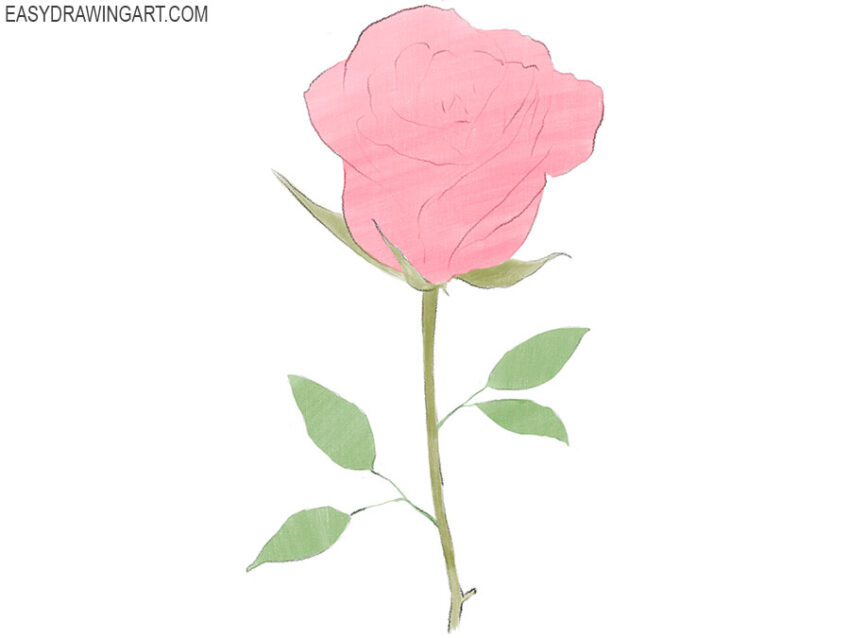
Step 4 – Add initial shadows to the bud
Now, introduce depth by selecting a pink that is a shade darker than the base. Apply this color to areas where shadows naturally occur: beneath petal overlaps and at the base of the bud. Use a delicate touch to blend these shadows into the base color, creating a soft transition that suggests the curvature of the petals. This layering technique begins to turn the flat base into a three-dimensional form, playing with light and shadow to bring out the roundness of the petals and the depth of the flower’s heart.
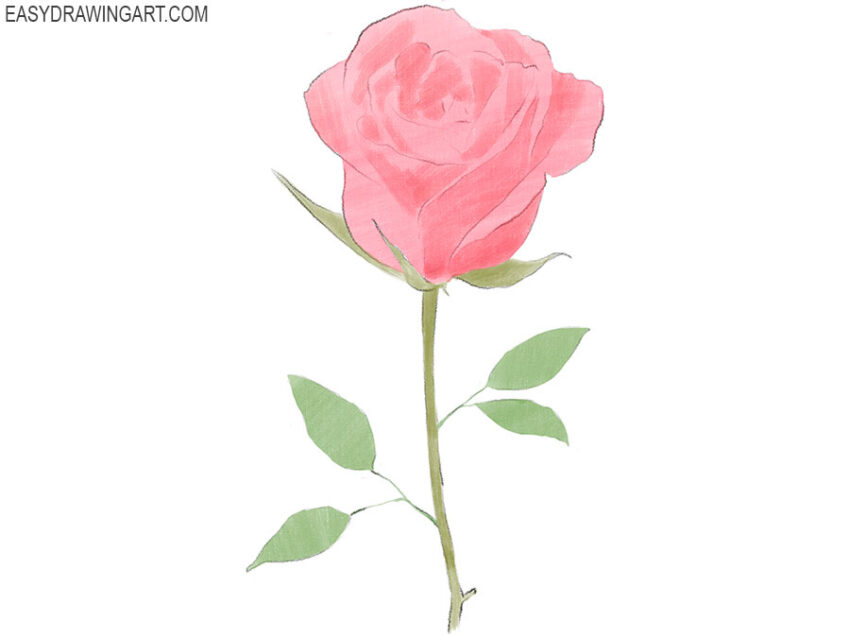
Step 5 – Add core shadows to the bud
Deepen the shadows by mixing a darker shade, possibly by adding a touch of purple or maroon to your pink. Identify the core shadows – the darkest parts of the flower, such as the very center where petals cup inward and areas completely turned away from the light. Apply this color sparingly but with confidence to accentuate the flower’s depth and volume. These core shadows are crucial for conveying the lushness of the petals and for creating a dynamic range of tones that suggest a complex interplay of light.
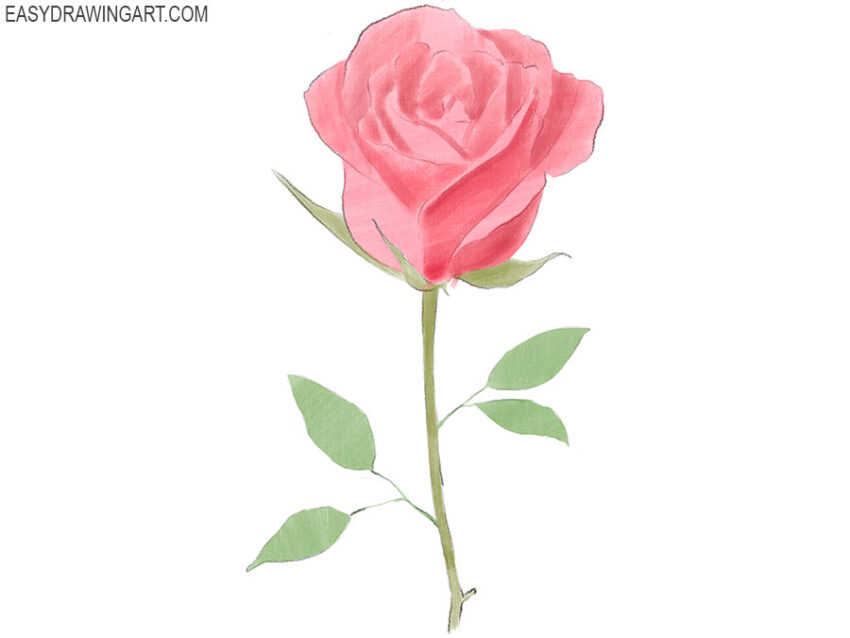
Step 6 – Adding more shadows and colors to the bud
Enhance the realism by incorporating various shades of pink, along with hints of red or purple, to establish a rich tapestry of color across the bud. Apply these colors to build up the shadows, using a blend of brush strokes to mimic the petal’s texture. This layering of color adds complexity and richness to your flkower painting, making it more lifelike. Each petal should now have a distinct form, contributing to the overall shape of the bud with its unique folds and bends.
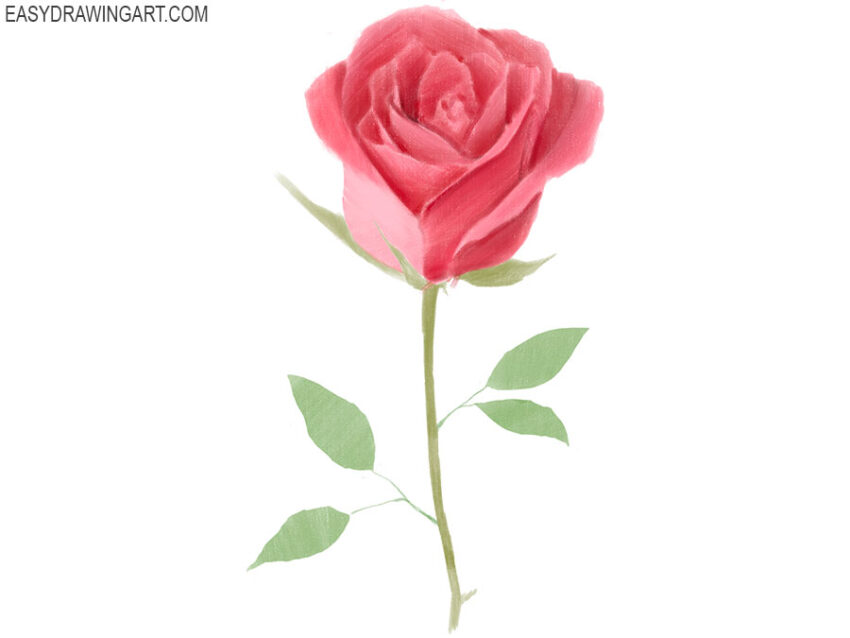
Step 7 – Add highlights and increase the contrast of the bud
Here is where your flower truly starts to shine. Using a light pink or even white, gently brush on the highlights where the petals catch the most light. Think about a light source and how it would kiss the top edges of the petals, adding a glow that suggests volume and softness. Simultaneously, revisit the shadows to punch up the contrast. This interplay between light and dark should be more pronounced now, giving your flower painting a dramatic, almost tactile presence. It’s a delicate balance between subtlety and boldness, enhancing the flower’s three-dimensional effect.
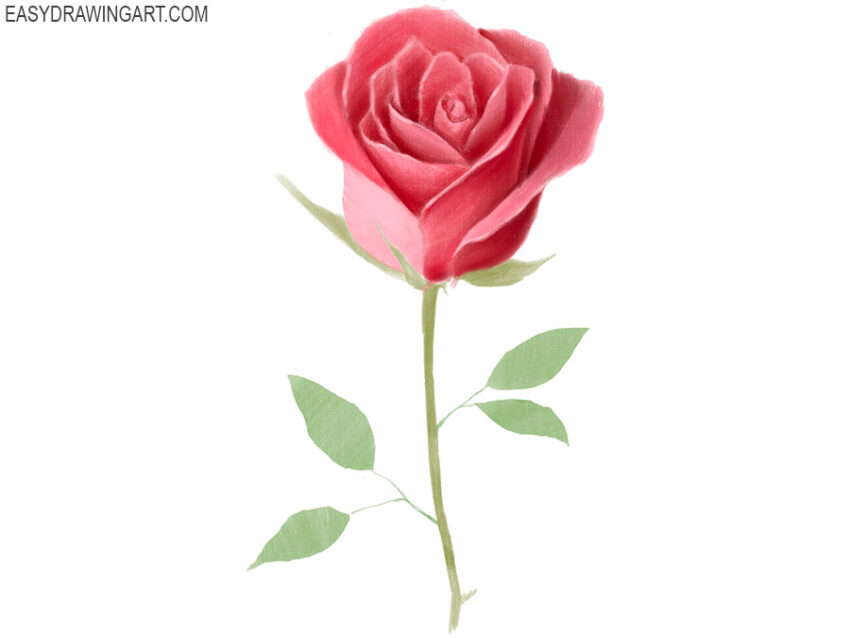
Step 8 – Add shadows and highlights to the stem
The stem now requires attention; it should not just be a conduit but a part of the painting with its own nuances. Add shadows with a darker green to show where the leaves might cast a shadow on the stem or where natural indentations occur. Then, with a lighter green, add highlights along the edges or where the stem curves, reflecting where the light naturally falls. This step is about reinforcing the stem as a three-dimensional object, supporting the bud both structurally and visually within your composition.
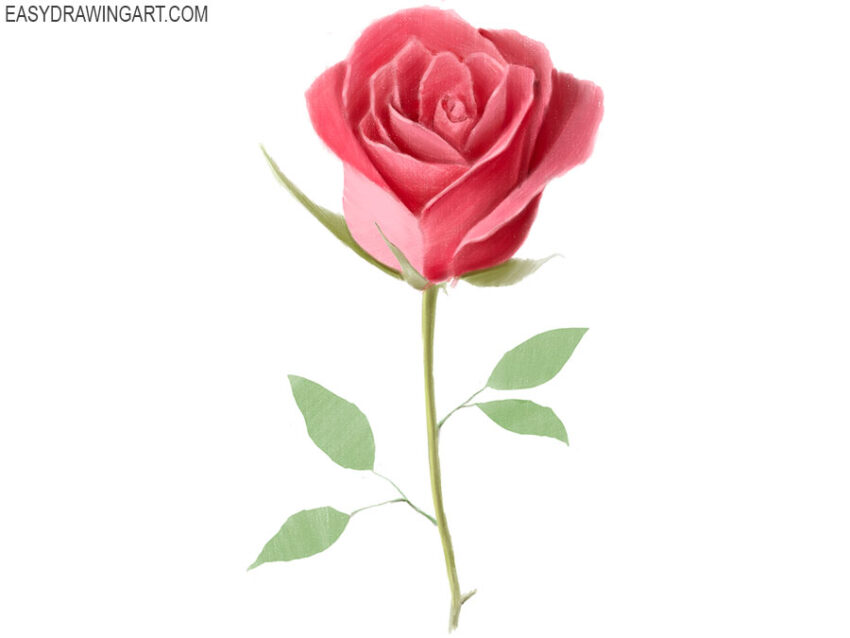
Step 9 – Add some final touches to your flower painting
Choose a shadow color that complements the existing greens, to cool the shadows and suggest a distance or thickness to the leaf of the flower. Apply this color to the lower parts of the leaves and along the veins to create texture and depth. In addition, study your entire flower painting. Add more contrast in those areas where it is needed. Add the necessary elements that were missed in the previous steps.
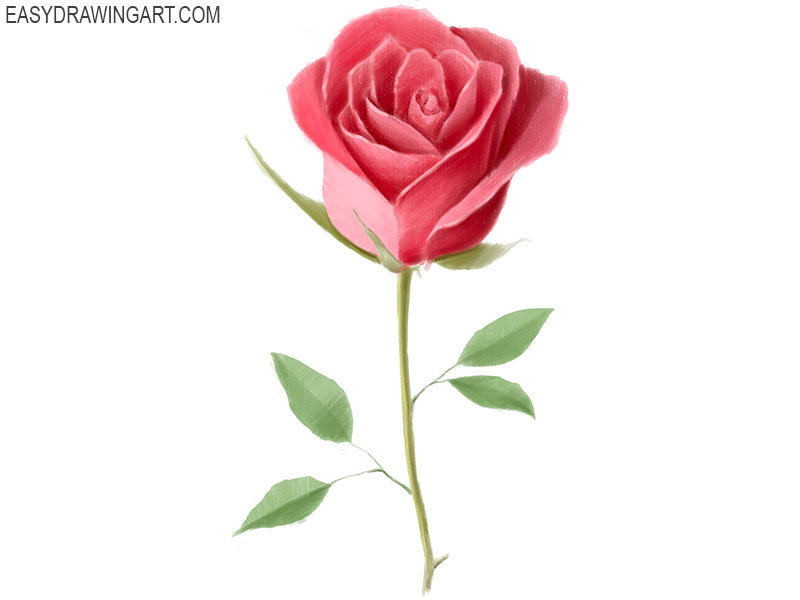
As we conclude this tutorial on how to paint a flower, it is important to recognize that the process itself, as much as the finished piece, is a rich, educational experience. Here are the key takeaways, that we learned from this painting lesson:
The delicate layers of petals, the subtle shifts in color, and the intricate details of a flower’s anatomy all require a slow and steady hand. Each stroke and each layer must be given time to dry, allowing the colors to settle and blend naturally. Patience is especially important when learning to paint a flower., as the complexity of natural forms demands both time and care to replicate accurately.
Every flower you paint can teach you something new. The way light filters through a petal, the structure of a stem, or the pattern of leaves—all these elements offer endless variety and complexity. With each new flower, challenge yourself to explore new techniques, such as using a palette knife for texture or thin glazes for translucency.
To paint flowers convincingly, you must become an astute observer of nature. Note how petals curve, where shadows fall, how colors change at different times of the day. The more you see, the more you can infuse your work with the essence of the real flower, capturing not just its appearance but its spirit.
As your familiarity with painting flowers grows, so too will your intuition. You’ll begin to know instinctively how to mix the perfect hue for a sunlit petal or the deep shadow within a flower’s center. This intuition is the voice of your experience speaking, guiding you to create art that feels alive.
Flowers are a universal subject in art, and there’s a wealth of knowledge to be found within the community of floral painters. Engaging with others, sharing your floral compositions, and observing how others approach similar subjects can provide fresh inspiration and new perspectives on your work.
In painting flowers, we capture the beauty of nature and connect with a long tradition of artists who have found solace and expression in the petals and stems of the botanical world.

